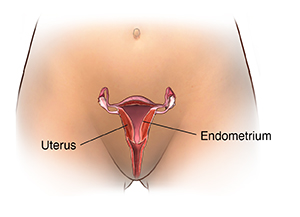How is endometrial cancer diagnosed?
If your healthcare provider thinks you might have endometrial cancer, usually because of abnormal vaginal bleeding, you'll need certain exams and tests to be sure. Endometrial cancer is cancer that starts in the lining of the uterus (endometrium). Diagnosing endometrial cancer starts with your provider asking you questions. They'll ask about your health history, symptoms, risk factors, and family history of disease. Your provider will also give you a physical exam. This will include a pelvic exam.
Diagnosis may be done by a gynecologist. Or you may see a gynecologic oncologist. These providers specialize in treating cancers and other diseases of the female reproductive organs.

What tests might I need?
You may have one or more of the following tests:
Transvaginal ultrasound (ultrasonography)
An ultrasound test uses sound waves to create images of internal organs on a computer screen. It’s done with a small wand called a transducer that’s placed in the vagina. The test creates pictures of the uterus. Ultrasound can show tumors and can be used to measure the thickness of the endometrium. The provider may do a biopsy if the endometrium looks too thick.
Sometimes a small tube is used to fill the uterus with salt water before doing the ultrasound. This may be called a hysterosonogram. Or a saline infusion sonogram. The saline helps the provider get a better image of any changes in the lining of the uterus.
Endometrial biopsy
A biopsy is when small pieces of tissue are taken and looked at with a microscope by a pathologist. A biopsy is the only way to confirm cancer. An endometrial tissue sample is collected by using a small flexible tube that's put into the uterus. Suction is used to pull out the tissue. The tissue sample is examined to see if there are cancer cells or other abnormal cells in it. This biopsy is often done in a healthcare provider’s office. It may also be done during a D&C.
Dilation and curettage (D&C)
Your healthcare provider may recommend a D&C if an endometrial biopsy isn't possible or more information is needed. This is a minor surgery in which the cervix is opened (dilated). The cervical canal and uterine lining are then scraped with a spoon-shaped tool called a curette. A pathologist looks at the tissue for cancer cells. Your provider may use a thin, telescope-like tube to look into the uterus at the same time. This is called a hysteroscopy. Usually a local anesthesia is used to help block pain during the procedure.
Getting your test results
Your provider will talk with you about next stages when they have the results of your tests. Your provider will talk with you about other tests you may need if endometrial cancer is found. This may include repeating the biopsy. Make sure you understand the results and what follow-up you need.